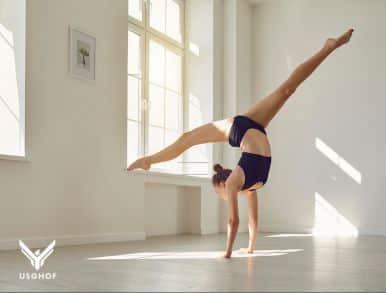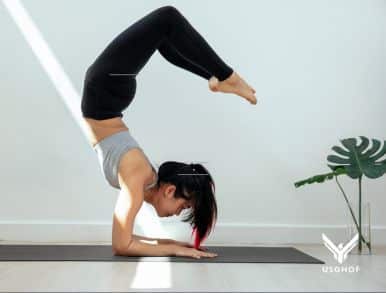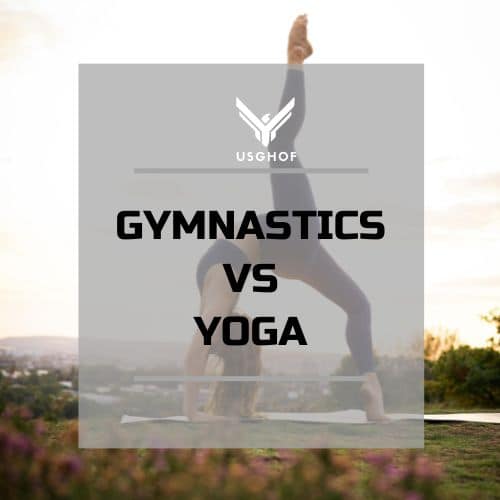Yoga and gymnastics are both physical disciplines that involve body movements, strength, and flexibility. While they share certain similarities, they have distinct characteristics that set them apart. Let’s delve into the key differences between gymnastics and yoga:
Philosophical Origins: Yoga VS Gymnastics
Yoga originated thousands of years ago in ancient India and encompasses a holistic approach to life, focusing not only on physical postures (asanas) but also on breath control (pranayama), meditation, and ethical principles. It incorporates the mind-body-spirit connection and seeks to promote overall well-being.

Gymnastics, on the other hand, traces its roots to ancient Greece, where it was primarily associated with physical exercises and athletic competitions. While gymnastics also emphasizes strength, flexibility, and control, it typically lacks the philosophical and spiritual dimensions found in yoga.
Purpose and Focus
Yoga is a multifaceted practice that aims to harmonize the body, mind, and spirit. Its primary focus is on promoting self-awareness, mindfulness, balance, and inner peace. Yoga sessions often involve slow and controlled movements, emphasizing proper alignment, breathing techniques, and relaxation. It places importance on cultivating a sense of unity within oneself and with the surrounding environment.
Gymnastics, on the other hand, is primarily a sport that emphasizes athletic performance, precision, and mastery of specific skills. Gymnasts engage in rigorous training to develop strength, agility, and flexibility in order to execute complex routines with precision, often involving high-flying acrobatics, flips, and somersaults. Competitive gymnastics also places emphasis on execution, difficulty, and artistic presentation.

Structure and Sequencing
Yoga typically follows a structured yet flexible approach, with various styles and sequences of asanas that cater to different needs and preferences. Classes may focus on gentle stretching and relaxation (e.g., Yin or Restorative yoga), dynamic and flowing movements (e.g., Vinyasa or Ashtanga yoga), or a combination of both. Yoga encourages practitioners to listen to their bodies, honor their limitations, and adapt the practice to suit their individual needs.
Gymnastics, on the other hand, follows a highly regimented and progressive training structure. It involves mastering specific skills and progressing through various levels of difficulty. Gymnastics routines are meticulously choreographed and designed to showcase a wide range of acrobatic movements, strength elements, and artistic expression.
Competitive Aspect
While yoga has evolved to include various competitive formats in recent years, such as yoga championships, traditional yoga does not have a strong competitive focus. The emphasis in yoga is often on personal growth, self-acceptance, and inner exploration rather than external competition.
Gymnastics, on the other hand, is widely recognized as a competitive sport. It is a part of prestigious events like the Olympic Games and involves rigorous training regimes, skill mastery, and performance evaluations through competitions.

In summary, yoga and gymnastics differ in their philosophical origins, purpose, focus, structure, and competitive aspects. Yoga prioritizes holistic well-being, self-awareness, and unity of mind, body, and spirit. Gymnastics, as a sport, emphasizes physical performance, skill mastery, and artistic presentation. Both disciplines offer unique benefits and cater to different individuals’ preferences, goals, and inclinations.
Distinctions Between Yoga Instructors and Gymnastics Coaches
Yoga instructors and gymnastics coaches are professionals who guide individuals in different physical disciplines. While there may be some overlapping skills, their roles, focus, and methodologies differ significantly. Check how long does it take to become a yoga instructor?
Here are the key differences between yoga instructors and gymnastics coaches:
Practice and Purpose
Yoga instructors primarily teach yoga, a holistic discipline that combines physical postures (asanas), breathing techniques (pranayama), meditation, and philosophical principles. The purpose of yoga is to cultivate self-awareness, mindfulness, and inner harmony. Yoga classes often focus on promoting physical flexibility, strength, and mental well-being.
Gymnastics coaches, on the other hand, focus on coaching gymnastics, a sport that involves rigorous physical training, skill development, and artistic expression. The purpose of gymnastics coaching is to train athletes to perform complex routines that showcase strength, agility, and precision. Gymnastics coaching often revolves around competitive training, routines, and execution of skills.
Teaching Methodology
Yoga instructors typically guide students through a series of poses, emphasizing proper alignment, breath control, and mind-body awareness. They create a safe and supportive environment for students to explore their individual practice, adapt poses to their abilities, and find a balance between effort and relaxation. Yoga instructors may also incorporate elements of meditation and mindfulness into their classes.
Gymnastics coaches, on the other hand, focus on training athletes to develop specific gymnastics skills, such as flips, twists, balance, and acrobatic movements. They design training programs, drills, and conditioning exercises to enhance strength, flexibility, and technique. Coaches closely monitor and correct the execution of skills, paying attention to form, timing, and precision. They also guide athletes in routine choreography and the artistic aspects of their performances.

Emphasis on Competitiveness
Yoga instruction generally does not have a strong emphasis on competition. Yoga classes typically foster a non-competitive environment, encouraging students to focus on their individual progress, self-acceptance, and personal growth. While some yoga practitioners may choose to participate in non-competitive events or demonstrations, yoga as a whole does not revolve around formal competition.
Gymnastics coaching, in contrast, centers around competitive training and performance. Gymnastics coaches work with athletes who participate in competitions, aiming to develop their skills, routines, and abilities to excel in judged events. Coaches focus on refining techniques, executing difficult skills with precision, and enhancing overall performance to achieve high scores and rankings.
Certification and Training
Becoming a certified yoga instructor typically involves completing a Yoga Teacher Training (YTT) program. These programs can vary in duration and focus, but they generally cover yoga philosophy, anatomy, teaching methodologies, and hands-on practice. Yoga instructors often seek additional certifications or specialized training in specific yoga styles or areas of interest.
Gymnastics coaches usually pursue certification through gymnastics governing bodies or organizations that provide coaching education programs. These programs encompass safety guidelines, skill progressions, coaching techniques, spotting, and competitive rules and regulations. Coaches may advance their knowledge and credentials by attending workshops, seminars, and continuing education opportunities specific to gymnastics coaching.
While yoga instructors and gymnastics coaches share a passion for physical activity and guiding others, their focus, teaching methodologies, and goals differ. Yoga instructors emphasize holistic well-being, self-awareness, and mindful movement, whereas gymnastics coaches concentrate on training athletes for competitive gymnastics, focusing on skills, routines, and performance.

